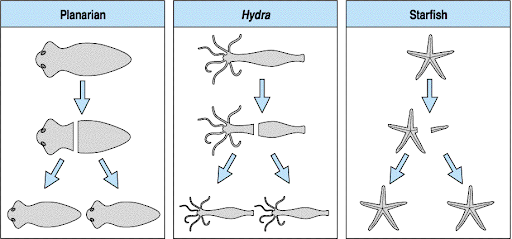Parthenogenesis: The miracle behind 'Virgin Birth'
Vova Prylepa. 08/28/2021

Biologically speaking, all animals have the blessing of procreation, the ability to bring a completely new individual into this world as a product of sexual intercourse between two partners of the opposite gender. However, some creatures can bypass the requirement of mating to create new life. Their bodies allow them to replicate themselves in such a way that the offspring contains the same biological information as the parent.
In some cases, the naturally occurring genetic modification will even produce fertile offspring. Nevertheless, some of the more highly intriguing processes hide behind a curtain of mystery from the public eye or have sunk into oblivion with the rest of the information learned in years of schooling. To shine some light onto some more precise concepts of parthenogenesis (also called incomplete asexual reproduction as sex cells are still involved), we will describe the four steps of the procedure, as well as some examples of the utility and marvels of this miraculous birthing.
Parthenogenesis consists of 2 main distinct phases: apomixis and automixis. Apomixis is the process of mitotic production of egg cells. In apomictic parthenogenesis, the oocyte, or female sexual cell, creates a copy of itself by mitosis, forming a pair of diploid cells. These diploid cells have all of the chromosomes needed for embryonary development. The derived offspring are exact copies of the parent cell. Some organisms that breed in this manner are aphids and flowering plants.
In automixis, egg cells are produced by meiosis. Usually, in egg cell development, the resulting daughter cells are split unevenly during meiosis. Asymmetrical cytokinesis eventually results in one large egg cell (oocyte) and several smaller cells called polar bodies. The polar bodies degrade without fertilization. The oocyte is haploid (has only a single set of unpaired chromosomes) and becomes diploid (has two pairs of completed chromosomes) after it is fertilized by male sperm. Because automictic parthenogenesis does not require male involvement, the oocyte becomes diploid by combining with one of the polar bodies or by duplicating its chromosomes. Since the following offspring is a product of meiosis, the occurring genetic recombination makes these individuals false clones of the parent cell.
Animal populations where individuals are scarce or isolated amongst themselves, benefit from parthenogenesis, as it removes the requirement of having a partner (for more than one organism to be present) for reproduction to be possible. If males are not accessible for sexual reproduction, parthenogenesis still grants the female a chance at procreation. More importantly, the females do not have to spend energy searching for a mate.
In most organisms, parthenogenesis produces only female offspring, which has a definite advantage over other forms of reproduction. Female offspring are able to contribute directly to the population of a species, being able to bear and produce the next generation. As a result, the rate of population growth is increased for organisms that use parthenogenesis than among related species that reproduce through a method that creates both male and female offspring. In other words, parthenogenesis offers a noticeable advantage when the objective of reproduction is to maximize the number of offspring with the shortest delays possible.
Since organisms created via parthenogenesis have a genetic code that belongs to only one individual instead of two, they are genetically stable.It means that all the cells that make up an organism contain identical genetic information which does not vary throughout their entire life. If a specific organism is particularly well suited to its niche and environment, and if that environment has sturdy living conditions, parthenogenesis can stabilize the species in the aforementioned environment even more. Nonoptimal genes may not be introduced into the genetic makeup of the species, and individual organisms can continue to thrive in an environment.
Though parthenogenetic reproduction can be advantageous, it is not as frequently encountered in animals as sexual reproduction, indicating its very specific advantages. Parthenogenesis can be disadvantageous because it limits the genetic diversity that comes from the recombination of genetic material. Recombination strengthens a species in the long term and allows for the selection of important traits.
Interestingly enough, parthenogenesis can also occur in humans. However, it cannot produce viable embryos, as unfertilized eggs lack necessary genetic information that is normally provided by sperm. Spontaneous androgenetic and parthenogenetic occurrences happen amongst humans, but instead of creating viable embryos, they form human-like benign tumors or primitive non-viable fetuses with imperfect body parts. Nonetheless, there was one reported case of partial-parthenogenesis; a young boy with all his cells (such as blood cells) left without his father’s DNA. He was perfectly healthy, excluding his asymmetrical facial features and learning difficulties. Tracing back to this boy’s biological origins, scientists can infer that an unfertilized egg began the process of self-division, but proceeded to have some of its cells fertilized by sperm in early development. In other words, the boy is a parthenogenetic chimera, because he has two cell lineages in his organism. There have been no scientifically confirmed reports of a clinically healthy nonchimeric human produced from a single, parthenogenetic-activated oocyte.
With the analysis of specific scenarios and historical evolution, parthenogenesis can be perceived as an animal way of reproduction, but one that excludes most mammals, including humans. In regards to the latter, no viable human embryos have ever been produced, so the miracle of virgin birth remains, in fact, a scientifically refuted phenomenon.
Cover photo: (Wikipedia)
